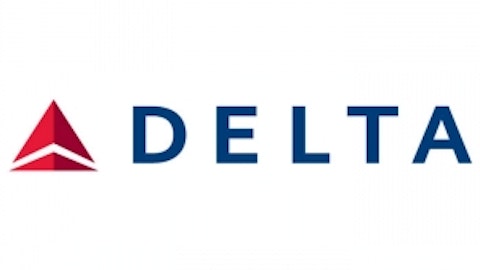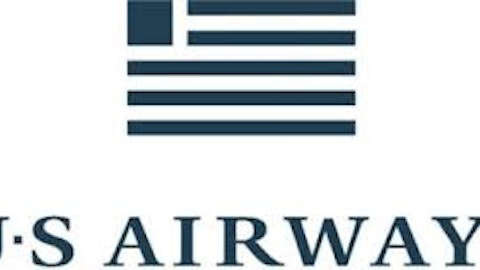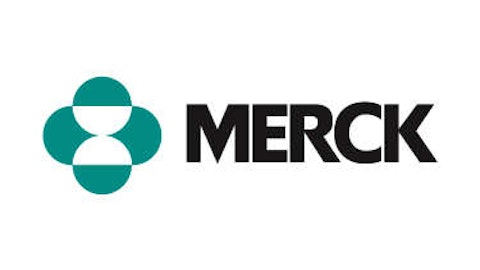Discount airline Spirit Airlines Incorporated (NASDAQ:SAVE) is both a survivor and a champion. When oil rose to $147 per barrel, many airlines struggled to survive. When the recession hit, many had their wings clipped. Spirit Airlines, however, defied those odds.
Not only has Spirit been profitable for four years in a row, but its share price has more than doubled since its public debut in May 2011.

The key to Spirit Airlines Incorporated (NASDAQ:SAVE)’s success is a mixture of steady growth, cheap tickets, and optional extra fees – and its growth story has apparently just started. Is this comparatively tiny airline – which now ironically has a larger market cap that American Airlines’ parent company AMR Corporation (PINK:AAMRQ) – about to grow up and become the next Southwest Airlines Co. (NYSE:LUV)?
Fourth quarter and full-year earnings
For its fourth quarter, Miramar, Fla.-based Spirit Airlines earned 27 cents per share, or $19.6 million, a decrease from the 33 cents per share, or $24.0 million, it posted in the prior year quarter. However, this topped the Thomson Reuters consensus of 24 cents per share.
Spirit Airlines Incorporated (NASDAQ:SAVE) attributed the weaker fourth quarter to cancellations resulting from Hurricane Sandy last October. Sandy cost the company an estimated $25 million.
Revenue rose 19.8% from $273.9 million to $328.3 million, also beating the consensus estimate of $327.76 million.
For the full year, Spirit’s profits soared 41.9% to $108.5 million, while revenue improved 23.1% to $1.32 billion. This marks the company’s fourth consecutive profitable year – a rarity in the struggling airline industry.
More flights, more destinations
Spirit Airlines is the fastest growing airline at McCarran Airport in Las Vegas, and averages 19 flights daily to 11 destinations. The airline now offers more flights from Las Vegas than both US Airways Group, Inc. (NYSE:LCC) and Allegiant Travel Company (NASDAQ:ALGT).
Spirit Airlines Incorporated (NASDAQ:SAVE) is still expanding. It started 28 new routes during the fourth quarter, with three routes arriving in or departing from Las Vegas. It also started flights between Las Vegas and Houston in October. The company also added flights to Detroit and Denver, where it intends to run a daily nonstop service between the two cities. Flights from Las Vegas to Baltimore-Washington and Philadelphia will commence on April 25.
To handle the new load, Spirit, which has a fleet of 45 planes, will receive nine new aircraft during the year.
The spirit of efficiency
Spirit is notably more efficient than its rivals in using its existing aircraft. Spirit keeps its planes in the air for 13 hours a day, while its rivals JetBlue Airways Corporation (NASDAQ:JBLU) and Southwest only keep them airborne for 12 and 10.5 hours, respectively.
Spirit Airlines Incorporated (NASDAQ:SAVE)’s aircraft are also a bit more cramped than its rivals – a Spirit Airbus A320 is equipped with 178 seats, while JetBlue Airways Corporation (NASDAQ:JBLU)’s A320 has 150. Revenue from 28 more passengers per flight adds up quickly.
‘That’ll be $100 to check that bag, sir.’
Spirit Airlines’ business model is largely dependent on “ancillary fees” – extra fees for services such as luggage, ticket bookings and food. The company attracts customers with cheap fares (as low as $9), then adds on extra fees for desired services. Discount airline Ryanair Holdings plc (ADR) (NASDAQ:RYAAY) is also known to implement this system of cheap tickets paired with extra fees.
For carry-on luggage (besides a small bag or personal item), Spirit passengers must pay $35 during online booking, while Spirit’s fare club members have to pay $25. If passengers forget to pay in advance, they are required to pay $50 at the airport kiosk.
Checked-in luggage costs $30 during online booking ($20 for members), $45 at the airport kiosk, and $100 if checked at the gate.
Spirit also charges for food and beverages, implements ticket change and cancellation fees, as well as a controversial passenger usage fee – which charges $9 to $17 for all tickets not purchased at airport ticket counters – to boost its ancillary revenue.
Although these fees have been unpopular with travelers, they substantially boosted the company’s bottom line — $139.5 million, or 42.5%, of its fourth quarter revenue was reported as “non-ticket operating revenues,” most of which came from these ancillary fees – a 33.3% increase from the prior year quarter. For the full year, non-ticket operating revenues rose 40.4% to $535.6 million.
A weak start to the year?
Spirit’s revenue passenger miles rose 18.1%, and its available seat miles rose 20.8% in February compared to the previous year. However, its passenger load factor – used to measure an airline’s ability to utilize the total capacity of its aircraft – dropped 2 percentage points to 83.2%. In other words, although individual passengers paid more, the average number of passengers per flight dropped. Total recorded departures also rose 15.3% from 5,582 to 6,436.
CEO Ben Baldanza remained optimistic regarding Spirits’ growth prospects in March, stating, “We believe the strength in demand we are experiencing in March will fully offset the load factor decline experienced in February, which was primarily driven by Northeast schools canceling their winter break.”
The Foolish Fundamentals
We should also evaluate Spirit’s fundamental performance against industry rivals JetBlue Airways Corporation (NASDAQ:JBLU), Ryanair Holdings plc (ADR) (NASDAQ:RYAAY), and Southwest.
| Mkt. Cap | Forward P/E | Price to Sales (ttm) | Return on Equity (ttm) | Debt to Equity | Profit Margin | |
| Spirit Airlines | $1.75 billion | 10.00 | 1.30 | 20.67% | No debt | 8.23% |
| JetBlue Airways | $1.91 billion | 9.61 | 0.37 | 7.02% | 151.01 | 2.57% |
| Ryanair Holdings | $11.48 billion | 13.23 | 1.19 | 18.99% | 111.23 | 12.54% |
| Southwest Airlines | $9.06 billion | 10.38 | 0.53 | 6.07% | 45.11 | 2.46% |
| Advantage | JetBlue | JetBlue | Spirit | Spirit | Ryanair |
Source: Yahoo Finance, March 14
Both Spirit and Ryanair, which are more heavily dependent on ancillary fees, have stronger margins and better return on equity than JetBlue Airways Corporation (NASDAQ:JBLU) or Southwest, which charge fewer extra fees.
Compared to Ryanair Holdings plc (ADR) (NASDAQ:RYAAY), Spirit has an important strength – no debt. That clean balance sheet will make it much easier to fulfill its plans to expand its fleet and routes.
Those positive catalysts also contribute to Spirit’s higher valuation. But do Spirit’s top and bottom line growth justify its higher P/E and P/S multiples?
Although Spirit’s top line growth has easily outpaced its rivals over the past 12, its bottom line growth has lagged. Southwest, on the other hand, exhibits the opposite problem – rising earnings along with poor revenue growth.
However, growth percentages don’t accurately reflect the company’s earnings per share. On an earnings per share basis, Spirit Airlines’ $1.49 per share is higher than Southwest’s $0.56 and JetBlue’s $0.39, but lower than Ryanair’s $2.76 per share. This indicates that Spirit Airlines is right to follow Ryanair’s business model of offering lower fares paired with high ancillary fees.
The Bottom Line
Spirit Airlines deserves to trade at a premium to its rivals. The company operates efficient flights with higher seat counts and longer operating hours. It strategically grows its fleet and spreads its routes at a steady, sustainable pace. Ancillary fees will keep it profitable if oil prices rise and traveler demand wanes, giving it an edge over its rivals. Thanks to all these positive growth factors, I think it’s safe to say that Spirit Airlines will soar in 2013 and beyond.
The article Will This Airline Soar in 2013? originally appeared on Fool.com and is written by Leo Sun.
Copyright © 1995 – 2013 The Motley Fool, LLC. All rights reserved. The Motley Fool has a disclosure policy.






